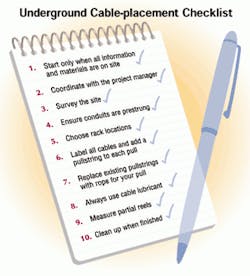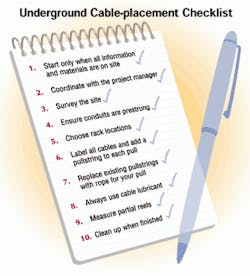The dos and don'ts of underground prewiring
Unwritten rules for outdoor cable placement can vary significantly from those for indoor placement.
Professionals who install cable inside buildings know that before you can carry out the task, you must coordinate with other trades. Once the coordination is established and the job begins, you must then abide by certain procedural guidelines to ensure the job goes smoothly. And when the cable installation is finished, that doesn't necessarily mean the entire job is finished. Some post-installation procedures may be necessary.
The same is true for those who install cable in outside-plant environments-particularly underground. Though the procedures may differ from those implemented inside buildings, they are still crucial.
For newcomers to underground cable placement, and to serve as a reminder to those with experience, here are 10 tips that can help ensure a successful underground cable pull:
1. Do not start the pull until all information and material are on the job site.
By "information," I mean:
- A set of the latest plan revisions or instructions;
- A set of plans that has been approved by the fire marshal, if appropriate;
- A copy of the specifications, to let you know if a certain number of spare wires are required;
- Documentation of any change orders that might affect the wire count.
For "material," make sure you have:
- Racks and jacks. No, not the 19-inch-wide racks and 8-pin modular jacks you see in telecommunications rooms. The racks and jacks used in underground cable placement are apparatus upon which you place the cable reels.
- Sufficient ladders, particularly if you plan to access deep vaults.
- A rope no less than 1/4-inch thick. The larger the rope, the easier the pull. Ensure that the rope is in good condition and is long enough for the pull.
- An electric-wire puller, frequently called a "tugger." This tool is always handy, because you never know when a seemingly easy pull will become difficult. Also, remember pulleys and cable lubricant.
- Wet/dry vacuum. It's particularly useful when you need to add a pullstring. (So, bring your pullstring, too.)
- Wire socks. If you don't have any, you can make some using tie wire.
- Cleanup material. Get rags, rags, and more rags. Also, paper towels, buckets, sponges, trash bags, and a broom.
2. Coordinate with the project manager to assure you can access all locked areas and easements. If you're working on a weekend or holiday, you probably will be able to get a key from the property owner or general contractor. Be sure you have backup telephone numbers for all parties in case the unexpected happens. Also, be sure to inform the project manager of any on-the-site decisions for which the project manager is not present.
3. Survey the site for job readiness:
- Stake out the area you will need to work in, and find out if any other trades will have to occupy the area at the same time.
- Review all your pull locations before setting up, and take the opportunity to put into place more efficient methods.
- With plans and specifications in hand, locate the vaults and tag the conduits that you'll use. Sometimes, diagrams in the electrical section of the original plans-located in the general contractor's trailer-detail the conduits' uses. Pay strict attention to the details. Also, check change orders because there are often changes to the specifications for number and size of conduits.
4. Take the time to ensure all conduits are prestrung. The time spent checking now can prevent long delays once the job begins. It may not be your job to prestring the underground conduit; often, specifications include instructions for the electrician to install the strings.
- If pullstrings are the electrician's responsibility but are not already in the conduit, contact the electrical foreman to find out when the task will be done.
- If you're pulling in your own string, take advantage of the time by measuring the runs. While you're measuring, swab the pathway by pulling a rag through with cable lubricant. Once you measure, make sure you write the measurements on the plans so they can be incorporated into the as-built drawings.
- If you have to measure the conduit (or have partial reels), lay the string that you use for measurement on the ground. Spread it out between two stationary objects, such as two buildings or a building and a telephone/light pole-this will give you an idea of the actual cable length. Then lay the cable out in the same location. This whole process should help you pinpoint any misjudgments or cable shortages before you begin placing the cable.
5. Decide the best location for the racks. Don't set them up too close to the point at which you'll work. The cable rolls off the reels much more easily and backlashes less frequently when there is adequate space between the reels and the feeding site.
- Once you've decided the appropriate locations, clear the areas of all gravel or other debris that might damage the cable.
- Decide whether it will be more advantageous to pull from the middle or either end. With long cable runs, it is often easier to pull from the middle in one direction, then measure again and pull from the middle in the other direction.
6. Label all cables and add a pullstring with every pull. Try to label the cables with actual building or room numbers. (Information is often available that will let you determine the appropriate building or room number-even in new construction.) Pullstring installation frequently is required in the specifications. But in cases of long runs, or when there's no room for any more cable in a conduit, pullstring installation may be impractical or ill-advised.
7. Replace all pullstrings with rope before you start your pull. (Caution: By using the pullstring, you will cut the PVC, which will cause the pull to get stuck.) A rope will work much better than a pullstring will. When you replace the pullstring with a rope, pull a rag in with cable lubricant to ensure there are no foreign objects in the way.
8. Use cable lubricant continually, not just at the beginning of the pull. There's always a chance that you'll have to add cables later, and a fully lubricated pathway will make the future pull easier.
- Other ways to ensure a smooth pull include staying in sync with the worker on the other end of the pull.
- Remember, it is possible to push the cable, which will make it easier for the person pulling on the other end.
- Once you have completed the pull, make sure the cable is properly secured to prevent damage, and inspect the labels to make sure they survived the pull.
9. Always measure partial reels. It takes a lot less time to measure a partial reel than it does to repull a cable that came up short. When you have new, full reels, use them for long runs first. Do not use the same reels for all the runs. Manage your cable in such a way that you can make all the pulls without ever coming up short.
10. Clean up all trash when you're finished:
- Make sure the cable is properly secured to prevent damage;
- Make sure you tie any cables running inside vaults above the water line, or to anchors (if they're available);
- Double-check all cables to ensure they are labeled;
- Take the time to document your work for the as-builts;
- Leave the area at least as clean as you found it.
There are, of course, more elements that go into underground cable placement. But if you use these 10 steps as a checklist, you will be well on your way to a successful job.
Richard E. Rhodes is a senior journeyman technician with Construction Electronics Inc. (San Diego, CA), and a member of Local 569 of the International Brotherhood of Electrical Workers.

